The Event Horizon Telescope (EHT) is an array that links together eight existing radio observatories across the planet to form a single Earth-sized virtual telescope. The telescope is named after the "event horizon," the boundary of the black hole beyond which no light can escape.
On this page you can find information about the EHT collaboration and its discoveries, as well as multimedia and other resources.
 On this page
On this page
Media contacts
For media inquiries, please email media@nsf.gov or call (703) 292-7090.
Subscribe
Sagittarius A*: First image of the black hole at the center of the Milky Way
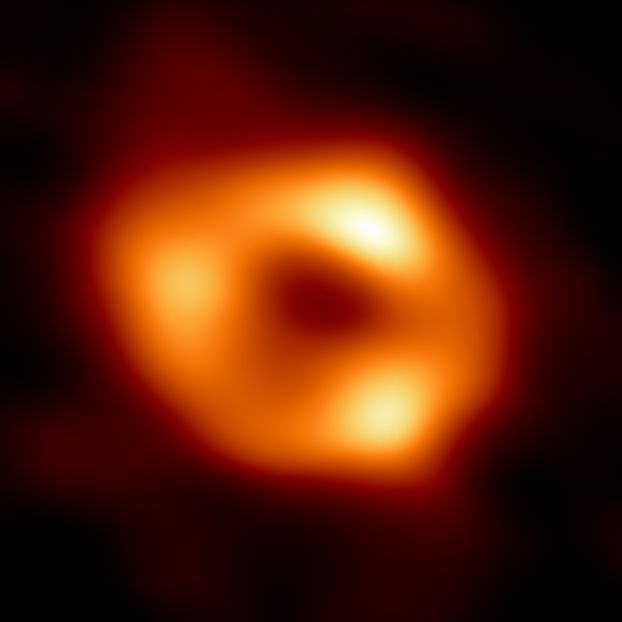
Credit: Event Horizon Telescope Collaboration
This is the first image of Sagittarius A*, or Sgr A*, the supermassive black hole at the center of our galaxy. It's the first direct visual evidence of the presence of this black hole. It was captured by the Event Horizon Telescope (EHT), an array that links together eight existing radio observatories across the planet to form a single Earth-sized virtual telescope. The telescope is named after the "event horizon," the boundary of the black hole beyond which no light can escape.
Although we cannot see the event horizon itself, because it cannot emit light, glowing gas orbiting around the black hole reveals a telltale signature: a dark central region, called a "shadow," surrounded by a bright ring-like structure. The new view captures light bent by the powerful gravity of the black hole, which is 4 million times more massive than our sun. The image of the Sgr A* black hole is an average of the different images that the EHT collaboration has extracted from its 2017 observations.
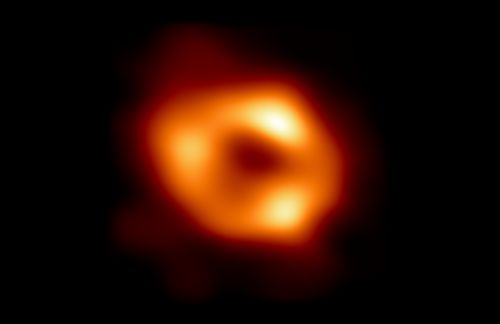
We got it! Astronomers reveal first image of the black hole at the heart of our galaxy
This result provides overwhelming evidence that the object is indeed a black hole and yields valuable clues about the workings...
May 12, 2022 newsAdditional images
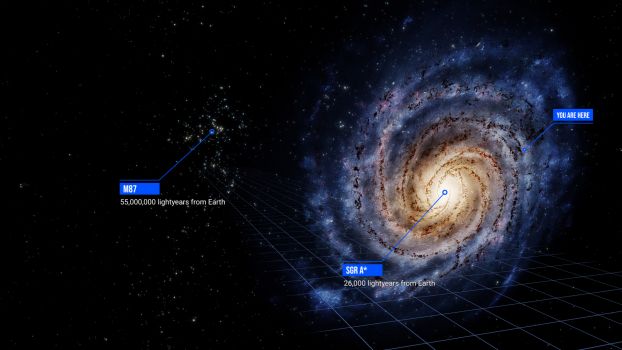
Credit: U.S. National Science Foundation/Keyi "Onyx" Li
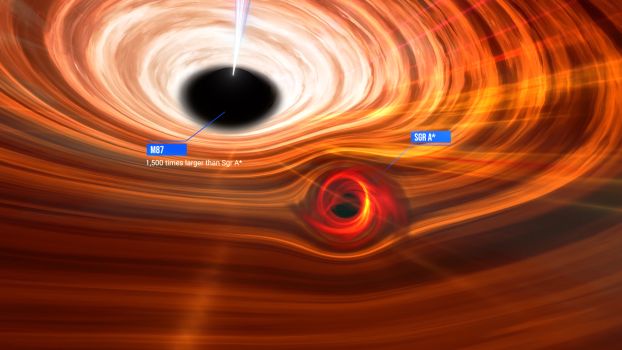
Credit: Keyi "Onyx" Li/U.S. National Science Foundation; Lia Medeiros, Institute for Advanced Study
Videos
NSF press conference revealing the image of the black hole at the center of the Milky Way
Additional B-roll (Credit: U.S. National Science Foundation):
- Contains eight EHT telescopes and two data centers identified on slates. Download video (MP4, 135.7 MB)
- Contains eight EHT telescopes and two data centers identified on screen. Download video (MP4, 133.5 MB)
M87*: The first image of a black hole
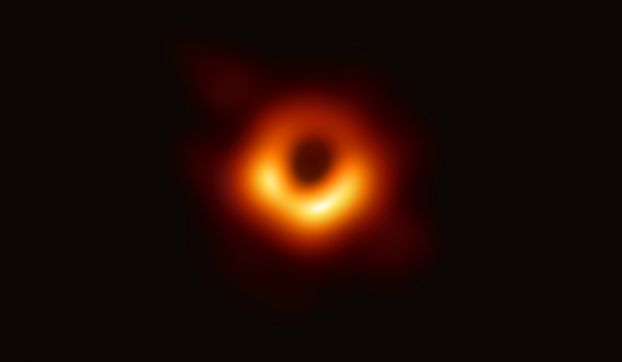
Credit: Event Horizon Telescope Collaboration et al.
Using the Event Horizon Telescope, a planet-scale array of eight ground-based radio telescopes forged through international collaboration, scientists obtained the first direct visual evidence of a supermassive black hole, outlined by emission from hot gas swirling around it under the influence of strong gravity near its event horizon.
The image reveals the black hole at the center of Messier 87, a massive galaxy in the nearby Virgo galaxy cluster. This black hole resides 55 million light-years from Earth and has a mass 6.5 billion times that of the sun.
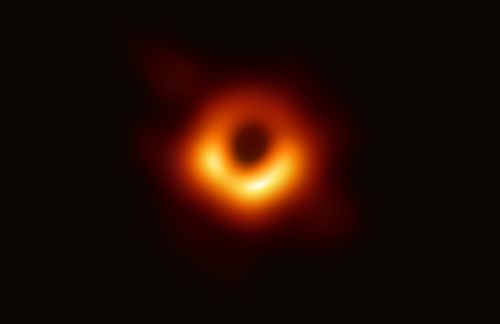
Astronomers capture first image of a black hole
National Science Foundation and Event Horizon Telescope contribute to paradigm-shifting observations of the gargantuan black hole.
April 10, 2019 newsVideos
About the Event Horizon Telescope
Images and diagrams
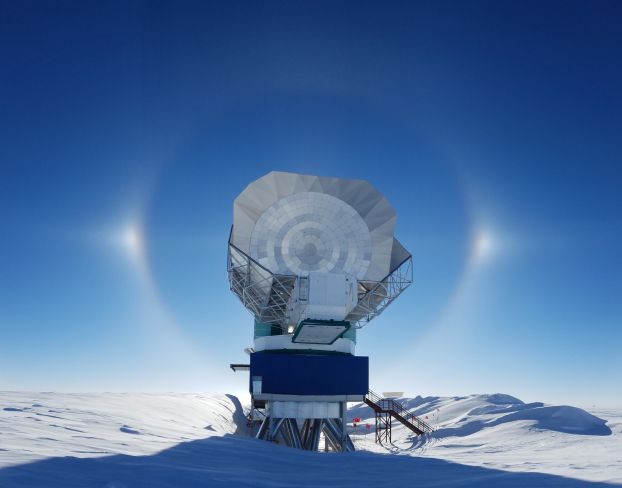
Credit: Junhan Kim/University of Arizona

Credit: David Harvey

Credit: U.S. National Science Foundation
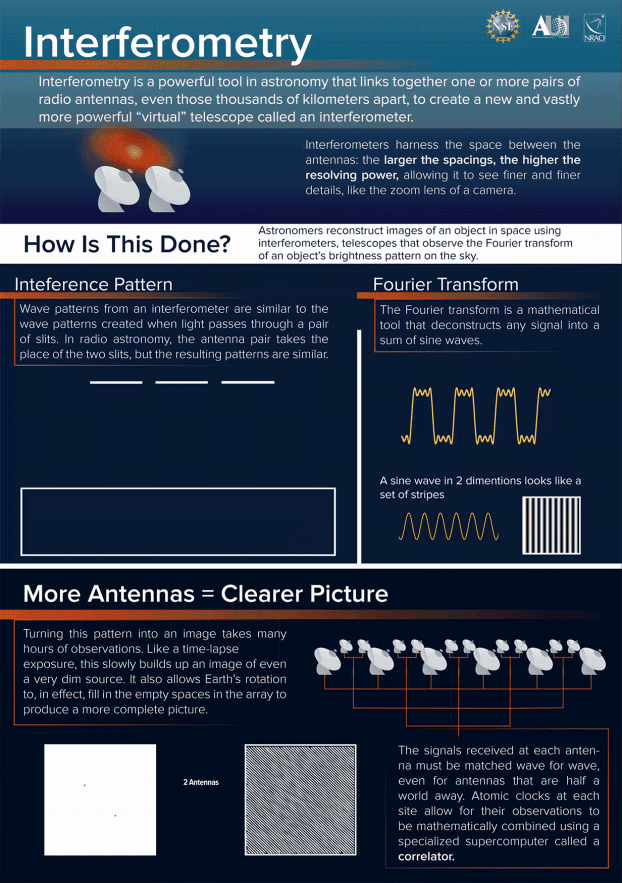
Credit: U.S. National Science Foundation
Interferometry is a powerful tool in astronomy that links together one or more pairs of radio antennas, even those thousands of kilometers apart, to create a new and vastly more powerful "virtual" telescope called an interferometer.
Interferometers harness the space between the antennas: the larger the spacings, the higher the resolving power, allowing it to see finer and finer details, like the zoom lens of a camera. [Illustration of two antennas moving father apart and loser together.]
How is this done?
Astronomers reconstruct images of an object in space using interferometers, telescopes that observe the Fourier transform of an object's brightness pattern on the sky.
Interference pattern
Wave patterns from an interferometer are similar to the wave patterns created when light passes through a pair of slits. In radio astronomy, the antenna pair takes the place of the two slits, but the resulting patterns are similar. [Diagram depicting the propagation and interference of waves passing through two slits. At the bottom of the diagram is a box that lights up with vertical lines representing the interference patterns.]
Fourier transform
The Fourier transform is a mathematical tool that deconstructs any signal into a sum of sine waves. [An illustration of jagged, repeating waves, which are transformed into a smooth sine wave.]
A sine wave in two dimensions looks like a set of stripes.
More antennas = clearer picture
Turning this pattern into an image takes many hours of observations. Like a time-lapse exposure, this slowly builds up an image of even a very dim source. It also allows Earth's rotation to, in effect, fill in the empty spaces in the array to produce a more complete picture. [Illustration of many antennas, connected through a series of lines, each transmitting information along the network.]
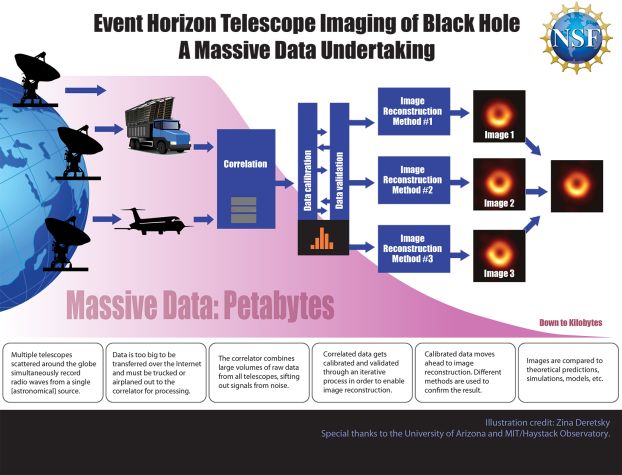
Credit: Zina Deretsky (illustration); and special thanks to the University of Arizona and MIT/Haystack Observatory
A diagram with the title "Event Horizon Telescope Imaging of Black Hole A Massive Undertaking." The bottom of the diagram contains the label "Massive data: Petabytes down to kilobytes." The diagram illustrates the following:
- Multiple telescopes scattered around the globe simultaneously record radio waves from a single [astronomical] source.
- Data are too big to be transferred over the internet and must be trucked or flown out to the correlator for processing.
- The correlator combines large volumes of raw data from all telescopes, sifting out signals from noise.
- Correlated data gets calibrated and validated through an iterative process in order to enable image reconstruction.
- Recalibrated data moves ahead to image reconstruction. Different images are used to confirm the result.
- Images are compared to theoretical predictions, simulations, models, etc.
Videos
You can also download a 10-section version of this animation. Download video (MP4, 5.3 MB)
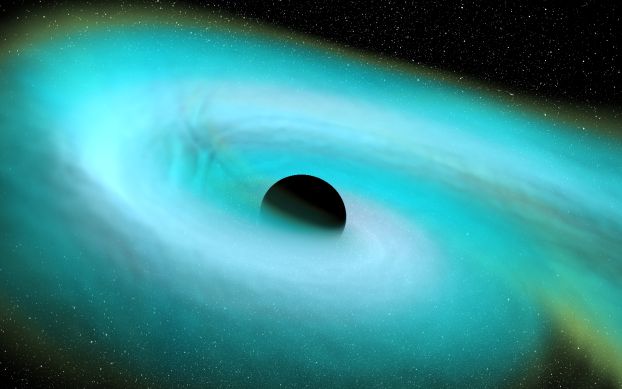
About black holes
Visit the NSF Black Holes page to learn about the nature of black holes, read about the latest news and immerse yourself in spectacular images and videos.


